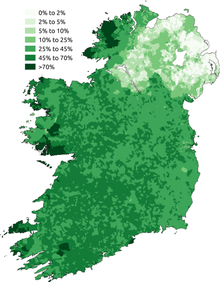Irish language
| Irish | |
|---|---|
| Irish Gaelic Gaelic | |
| Standard Irish:Gaeilge Gaeilge na hÉireann | |
 "Gaelach" in traditional Gaelic type | |
| Pronunciation | [ˈɡˠeːlʲɟə] |
| Native to | Ireland |
| Region | Ireland, mainly Gaeltacht regions |
| Ethnicity | Historically white Irish, now Irish people of all ethnicities |
Native speakers | 73,804 in Ireland (2016)[1] 4,166 in Northern Ireland[2] L2 speakers: 1,761,420 in the Ireland (2016),[1] 104,943 in Northern Ireland (2011)[2] |
Early forms | |
Standard forms | An Caighdeán Oifigiúil |
| Latin (Irish alphabet) Irish Braille | |
| Official status | |
Official language in | |
Recognised minority language in | |
| Regulated by | Foras na Gaeilge |
| Language codes | |
| ISO 639-1 | ga |
| ISO 639-2 | gle |
| ISO 639-3 | gle |
| Glottolog | iris1253 |
| ELP | Irish |
| Linguasphere | 50-AAA |
 Proportion of respondents who said they could speak Irish in the Ireland and Northern Ireland censuses of 2011. | |
Irish, or Irish Gaelic, is a language spoken in the Republic of Ireland and, less commonly, in Northern Ireland.
Classification
[change | change source]Irish is a Gaelic language and so is similar to Scottish Gaelic and Manx. It is less similar to Breton, Cornish and Welsh.
The Celtic languages are divided into two groups: P-Celtic languages and Q-Celtic languages. Irish, Scottish Gaelic and Manx are Q-Celtic languages, and Breton, Cornish and Welsh is a P-Celtic language. For that reason, many Irish-speakers can understand some Scots Gaelic but not Welsh.
Irish has nowords for "yes" or "no".
History
[change | change source]Before the United Kingdom
[change | change source]Queen Elizabeth I of England tried to learn Irish and asked her bishops to translate the Bible into Irish.[4] That was an attempt to split the Catholic people from their clergy and make them Protestant, but it mostly failed.
In the United Kingdom
[change | change source]Until the 19th century, most people in Ireland spoke Irish. However, that changed after Ireland joined Great Britain in 1801 to form the United Kingdom. Ireland’s state schools became part of the British system and so had to teach English. Sometimes, they were not allowed to teach Irish.
The Catholic Church also began to discourage Irish. The same is true for the Irish Nationalist leader Daniel O'Connell. He was an Irish-speaker himself but thought that people should speak English since most job opportunities were in the English-speaking British Empire and United States.
Today
[change | change source]Today, Irish is the first official language of the Republic of Ireland and has around 2 million speakers.
In practice, the Irish government still uses English more than Irish. Also, most people in the country speak English in their day-to-day lives. However, many people speak Irish among friends or family. It is also taught in all Irish schools according to the law.
In parts of Ireland called the Gaeltacht (Gaeltachtaí in Irish), people still speak Irish as their first language, and up to 70% of the people speak Irish. The newest Gaeltacht in the country is on Falls Road, in Belfast, where the whole community tries to use Irish as its first language. The area is called the Gaeltacht Quarter.[5]
Literature
[change | change source]There were great poets who wrote in Irish. Their poems became songs. Often, they told stories about the heroes of old times.

Common words and phrase
[change | change source]- aon = one (ain)
- dó = two (doe)
- trí = three (tree)
- ceathair = four (ka-her)
- cúig = five (coo-igg)
- sé = six (shay)
- seacht = seven (shocked)
- ocht = eight (uckt)
- naoi = nine (knee)
- deich = ten (dje)
- céad = one hundred (kayd)
- dhá chéad = two hundred (gah kayd)
- Dia Dhuit = Hello (literal translation is "God be with you") (jia gwitch)
- Céad Mile Fáilte = One hundred thousand welcomes (kayd me-lah fall-tcha)
- Ceist ag éinne? = Anyone have a question? (kesht ag ayn-ye)
- Éire = Ireland
- go maith = good (go mah)
- Slán = goodbye (slahn)
- Leabhar = book (lao-er)
- Madra = dog (madjra)
Related pages
[change | change source]References
[change | change source]- ↑ 1.0 1.1 "7. The Irish language" (PDF). Cso.ie. Retrieved 24 September 2017.
- ↑ 2.0 2.1 "2011 Census, Key Statistics for Northern Ireland" (PDF). Nisra.gov.uk. Archived from the original (PDF) on 8 March 2013. Retrieved 10 June 2017.
- ↑ "Full list".
- ↑ The Field Day Anthology of Irish Writing Volume IV Irish Women's Writings and Traditions Deane, Seamus Angela Bourke Andrew Carpenter Jonathan Williams 2002 New York University Press New York New York page 365
- ↑ "Sin Fein talks about the Gaeltacht Quarter". Archived from the original on 2008-06-19. Retrieved 2008-10-31.
